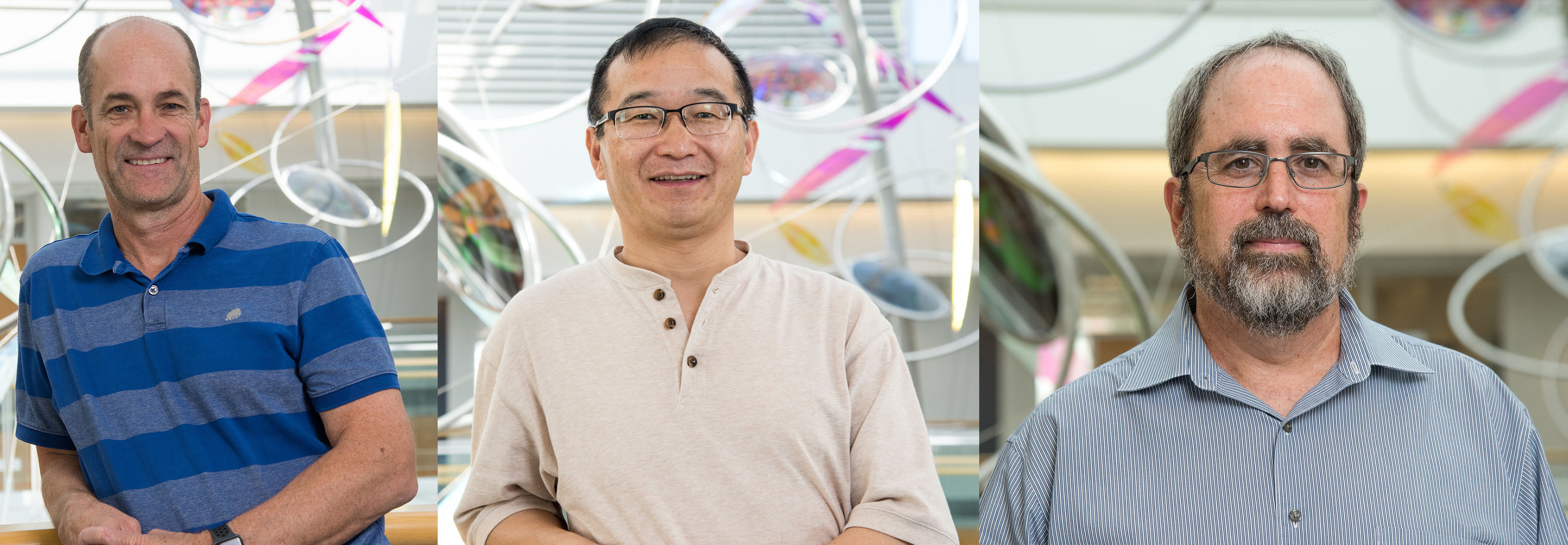
By Roger Meissen | Bond LSC
Like with any family, a new addition brings possibility and excitement.
For Bond LSC, three new faculty promise to enrich research at the University of Missouri by working together across disciplines. Ron Mittler, Wes Warren and Bing Yang all joined Bond LSC recently to continue their research careers.
Bond LSC Interim Director Walter Gassmann said these strategic hires are years in the making and represent how departments and centers come together with a unified goal for MU.
“These are some of the first hires we’ve completed specifically looking at how new faculty could bridge individual research strengths that exist on campus,” he said. “These scientists can bring those strengths together to go in a new direction, and Bond LSC is the perfect place for these faculty to achieve their goals.”
Each researcher comes with a reputation that precedes him. It only takes one look at the framed covers of Nature Magazine lined up in a row in Wes Warren’s office to see evidence of that. The comparative geneticist was recruited from Washington University and has published work in Nature that sequenced the genomes of animals from the orangutan and the gibbon to the elephant shark and the platypus.
“My passion is to crack the black box of the genome and try to find weird and unique traits of various animals,” Warren said. “It’s not enough now to sequence a genome and compare it to others, you have to dig deeper, do wet lab work and try to validate your findings.”
His shared appointment as a Bond LSC investigator and professor of genomics in the Department of Animal Sciences, College of Agriculture, Food and Natural Resources, in conjunction with the School of Medicine, College of Veterinary Medicine and the MU Informatics Institute, gives him the opportunity to more easily move his research forward.
“My thought is that I can act as a liaison between researchers in these areas,” he said. “I want to keep in mind trait evolution and use that divergence in traits to practice evolutionary comparative medicine to think about disease in humans and companion animals.”
Yang brings a different expertise from Iowa State University where he spent years studying bacterial diseases of rice. His joint appointment as a professor of plant sciences comes from a partnership with the Donald Danforth Plant Science Center in St. Louis. His research began by looking at plant disease from the bacterial side, but has evolved to also study its host’s interaction.
“Over half the world’s population eats rice as a staple food and by understanding its basic biology we can engineer better rice varieties with disease resistance and yield improvements,” Yang said. “This joint appointment gives me a bigger scientific community and access to more tools to continue my former research while thinking about some high risk, high reward projects that no one has done before.”
Mittler brings a different expertise in plant science to Bond LSC. Most recently at the University of North Texas, his work focused on cell-to-cell communication and how plants respond to multiple stressors — like heat and drought — at the same time. To do this, Mittler studies proteins with unknown functions. One he identified in plants deals with reactive oxygen species, which is a type of oxygen that becomes activated and can cause damage within cells in its toxic forms.
“We don’t really know what 20 percent of the proteins in our body do and in plants it’s more than that,” he said. “One of them was very interesting to me because it responded to reactive oxygen species in Arabidopsis plants, and we found out that a close relative of this protein is found in humans and accumulates to high levels in cancer cells.”
This has led Mittler to expand his work into mammalian cells and will encourage partnerships outside of plant science. With the cancer connection in mind, Mittler has a joint appointment in the Department of Surgery in the School of Medicine
“This is one of the few places in the U.S. that has a medical school, a veterinary school, college of agriculture and a nuclear reactor, so you have a lot of resources available to you, and here I have access to crop fields I didn’t have before and people who do a lot of crop physiology,” Mittler said. “The biggest thing I’ve found here so far is that there is a big drive for collaboration and the walls and barriers between different departments are low. Not a lot of places have this kind of attitude.”
The emphasis on connections across disciplines is key to the larger research goals within the University of Missouri System.
“It’s the research community, the facilities and resources that convince excellent researchers like these to join our research enterprise, and Bond LSC is the perfect place to have faculty from five colleges bump into each other on a daily basis,” said Mark McIntosh, vice chancellor of research, graduate studies and economic development at MU and vice president of research and economic development for the UM System. “Collaborative research is more competitive when it comes to grant applications to federal agencies, and is more likely to lead to innovations and economic development. Our success with interdisciplinary collaborations — like those in the Bond LSC — is the motivation for our focus on building the Translational Precision Medicine Complex (TPMC). I look forward to seeing how our new Bond LSC investigators can build and nurture these partnerships.”

